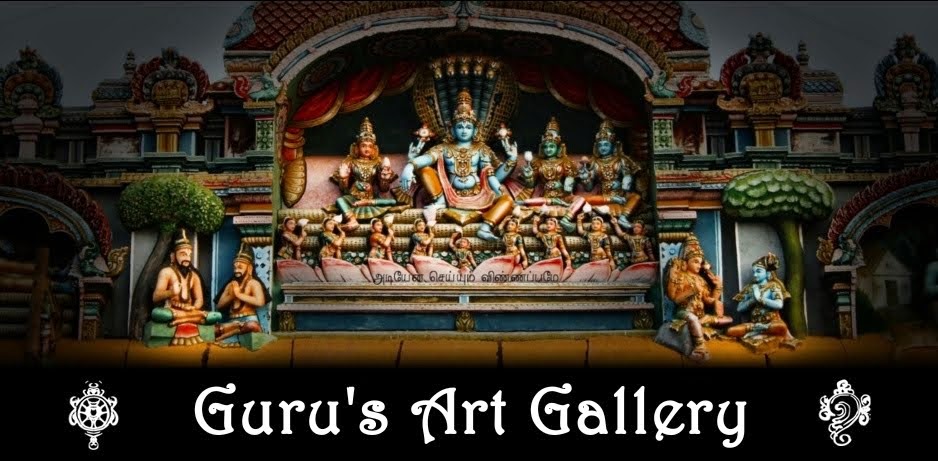Let us contemplate on Yogānandanṛsiṁha
[ svāti nakṣatra - sthiravāsara - 23rd April 2016 ]
 |
| Final painting of nrusimha |
Firstly the dhyana sloka :
अथ योगानन्दनृसिंहध्यानम् | अथर्वणसारे
- (श्रीमुम्मडि कृष्णराज ओडेयर् विरचितः - श्रीतत्वनिधिः - द्वितीयःसंपुटः - विष्णुनिधिः)
नित्यानन्दमयं निरञ्जनमजं निर्वाणसन्दायकं
निर्व्याजं निखिलक्षमादिसुगुणं नीरेजपत्रेक्षणम् |
जान्वोर्बद्धभुजं सुदर्शनदरात्युग्रायुधोद्यद्द्वयं
योगारूढनृसिंहमीशमनिशं ध्यायेत् त्रिणेत्रं हरिम् ||
Meditation on Yogānandanṛsiṁha | from atharvaṇasāra
- (śrīmummaḍi kṛṣṇarāja oḍeyar viracitaḥ - śrītatvanidhiḥ - dvitīyaḥsaṁpuṭaḥ - viṣṇunidhiḥ)
nityānandamayaṁ nirañjanamajaṁ nirvāṇasandāyakaṁ
nirvyājaṁ nikhilakṣamādisuguṇaṁ nīrejapatrekṣaṇam |
jānvorbaddhabhujaṁ sudarśanadarātyugrāyudhodyaddvayaṁ
yogārūḍhanṛsiṁhamīśamaniśaṁ dhyāyet triṇetraṁ harim ||
I contemplate on śrīYogānandanṛsiṁha, hari with three eyes. He is in eternal bliss and free from any attachment; He is birthless and gives liberation; without any external reason he posses all good qualities like forgiveness/tolerance; his eyes are long like the lotus petals. his hands rest on his knees. His other two hands carry two fierce weapons viz., a conch and a discus called sudarśana.
About yoga form
 |
| Initial sketch |
There are many classifications of images(vigrahas) in Indian Iconography. Generally people confuse Yoga form as merely the cross-legged-setaed posture, but there are yoga forms of vishnu in standing, sitting or reclining variants as well.
Here's a extract from the book "Elements of HINDU ICONOGRAPHY" by TA Gopinath Rao :
In the case of Vaishnava images each of these three kinds of images is further divided into yoga, bhoga, vira and abhicharika varieties. These varieties of the standing, sitting and reclining images of vishnu are worshipped respectively by those who desire to attain yoga or spiritual self-realisation, bhoga or enjoyment and vira or military prowess.
specific to the yoga form :
Among the aspects of vishnu the yoga form, be it standing, sitting or reclining, must be enshrined in a temple built far away from the bustle of village, on the banks of rivers, or at junction two or more rivers, on hill tops and in forest reccess. The reason of the choice of such place is quite patent. The worshipper of the yoga image has to be a yogi or one aspiring to become a yogi; He would certainly desire to have a calm place for concentrating his thoughts on the object of his worship; and naturally the temple is intended for the conduct of worship by him has to be away from human habitations.
Temples where this image is Enshrined
We can see that the shrines of yoga form of śrīnṛsiṁha is seen is many temples like
Ahobilam, Sholinghur(chozha-simha-puram/ghatikaachala) & Melukote(yadhugiri).
Most of these places are hill tops and in forest reccess as mentioend earlier.
Other subtle details of this painting
 |
| close up of the face |
- In aagama shashtras śrīnṛsiṁha is prescribed to be enshrined in hill tops forests etc or amdist sudharshana chakra. As per this rule, most of the south indian vaishnava temples have a nṛsiṁha amdist sudarshana. I have also added a shadkonam to represent sudharshana
- The shadkona(hexagram) which is the symbolism for sudharshana(in agama) happens to be symbolism of Anahata Chakra(heart) as well.
- Srivatsam is marked in right chest of nrusimha which is the pheeta of srimahalakshmi.
- He is also adorned with kausthubha maNi. This maNi represents the yogi who is so dear to him. Reminds of Krishna's words in Bhagavad gItA - jñānī tvātmaiva me matam
भगवद गीता -- "ज्ञानी त्वात्मैव मे मतम् "
 |
| close view of his lotus feet and padmasana |
- Also we have a aasana padma in which Nrusimha is seated(8petal).
- To depict his ugra(raudra) sharp nails, sharp teeth, etc are also captured.
- All typical ornamets and garments in indian iconography are also used to decorate him.
(ornamets - kirIta, makara kundala, graivEyaka, hAra, kEyUra, kataka, srivatsa, kausthubha, nUpura,etc
garments - udara-bandhana, mukthA-dhAma, bAhya-dhAma, kaichiguna, yOga-paTa etc)
 |
| योगानन्दनृसिंह |
This painting is A3 size - water+poster paint +ink on paper.
Comments and feedback are welcome.
Let us conclude with a mangala sloka on योगानन्दनृसिंह by Sriivanshatakopa Sriisriinivaasa Yatiindra Mahaadeshikan(ahobila-maTam)
[
www.prapatti.com/slokas/slokasbyname.html :
Navanaarasimha Mangalaashaasanam ]
चतुरानन-चेतोब्ज-चित्रभानुस्वरूपिणे |
वेदाद्रि-गह्वरस्थाय योगानन्दाय मङ्गलम् ||
caturānana-cetobja-citrabhānusvarūpiṇe |
vedādri-gahvarasthāya yogānandāya maṅgalam ||


























